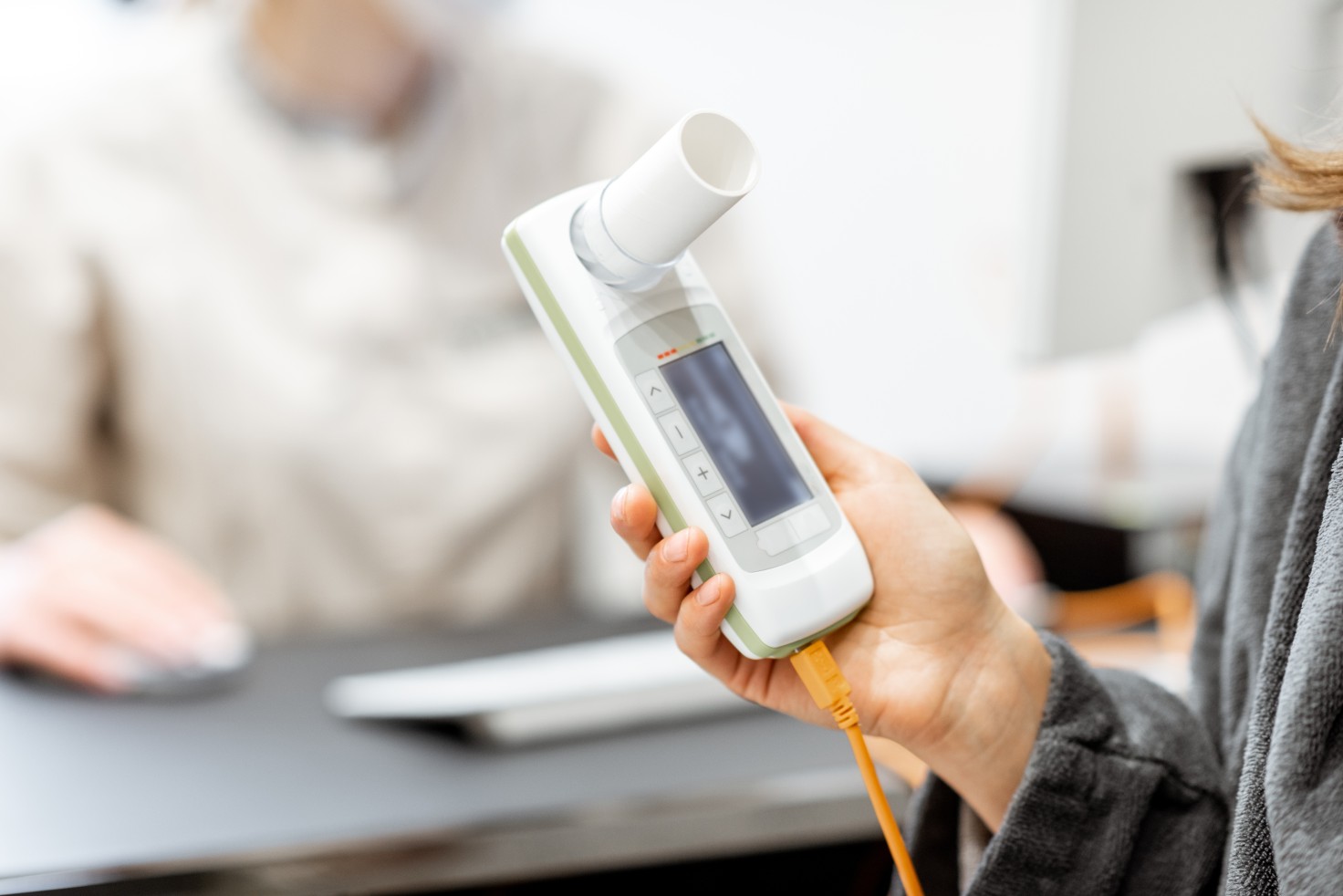FDA Authorizes the First Breath Test to Detect COVID-19

On August 14, 2022, the Federal Drug Administration (FDA) authorized the first breath test for COVID-19. The authorization is an important milestone for the current pandemic as testing methods continue to evolve. With a simple exhale, individuals could test positive for COVID in just three minutes. While a PCR test needs to confirm their case, the breath test is a powerful screening tool that could support better management of the current pandemic.
The breath test could also cater to testing for other illnesses, helping to combat future potential outbreaks. Rapid screening can help ensure patients receive an accurate diagnosis and treatment as soon as possible. It can also help states identify potential surges and take protective actions accordingly.
InspectIR Systems Creates COVID-19 Breath Test
Read More »About the Creators
Tim Wing and John Redmond are the startup founders behind the breathalyzer. Their story was recently featured in Forbes Magazine, highlighting their history. They met in 2008 at a Texas golf tournament. Wing had expertise in sales and marketing entrepreneurship. Redmond’s work history focused on human capital consulting in the technology industry.
The pair began with a venture related to touchless temperature measurements from a distance. The venture didn’t work as they hoped, leading to the launch of InspectIR in 2017. InspectIR began with a vision to create a cannabis breathalyzer. However, the pandemic hit, and the founders identified a different need – more testing for COVID-19.
The team needed chemistry expertise, so they enlisted professional help. InspectIR’s team began to work closely with professor Guido Verbeck, a chemistry professor at the University of North Texas (UNT). From there, the breathalyzer was created. Verbeck’s UNT bio notes his interests focus on “novel instrument development in mass spectrometry and ion optical devices in the areas of preparative mass spectrometry, miniaturization, and sample collection.” This made him the perfect contributor to InspectIR’s newest creation.
Creating the First COVID Breath Test
InspectIR Systems recognized the potential of breath tests for identifying infection. Scientists have spent years working to develop breath tests for lung cancer, liver disease, mesothelioma, and other serious illnesses. The pandemic led to research focused on the chemical breath patterns of COVID-infected patients.
The InspectIR team compared breath samples of a few dozen individuals with the infection and a few dozen of those without. This allowed the team to identify the “breath print” of SARS-CoV-2. Between the two groups, there were 41 differences that contributed to how the breath test works. According to the InspectIR website, “InspectIR is the first company to make a commercially available miniature mass spectrometer to analyze breath samples directly.”
Other scientists and companies have created breath-based tests for the virus. Some have been tested and authorized for use, but only in countries outside of the United States. The InspectIR Breathalyzer is slated to be the first in the United States.
How the Breathalyzer Works
The InspectIR COVID-19 breathalyzer works like a mobile chemistry lab. It uses gas chromatography gas mass-spectrometry to analyze a patient’s breath. When infected with the virus, an individual’s cells have a certain biological reaction. This creates gasses that enter the bloodstream and then the lungs. Individuals exhale the gasses, identifiable by the breath test. The device detects five Volatile Organic Compounds (VOCs) exhaled by individuals with SARS-CoV-2.
The breathalyzer is about the size of a 40-lb piece of carry-on luggage. Demo versions are currently housed in a hard rolling case. Patients must sit next to the device and breathe into a long straw for about 10 seconds. The exhale is similar to blowing up a balloon. Results are available in less than three minutes and displayed using proprietary software.
One caveat of the new breath test is it requires a trained and qualified operator. Testing should also occur under the supervision of a health care provider legally authorized to prescribe tests. When introduced, the breathalyzer will be available at sites where professionals collect and analyze specimens. This includes hospitals, doctor’s offices, and mobile testing sites. Availability at mobile testing sites could allow for more widespread testing in a shorter timespan.
How Accurate Is the COVID-19 Breath Test?
The FDA authorized the first COVID-19 breath test based on a recent study of more than 2,400 individuals. Some of them had COVID-19 symptoms and some of them did not. Results demonstrated 91.2% sensitivity and 99.3% specificity. In other words, the test accurately identified 91.2% of positive cases and 99.3% of negative cases. There were only false positives with 0.7% of the results.
InspectIR began clinical trials for the breathalyzer in 2020. It also conducted follow-up studies. According to the FDA, the follow-up study revealed the test had similar accuracy with Omicron variant detection. This variant has previously been difficult to identify and distinguish from other virus variants.
Despite the COVID-19 breath test’s accuracy, it is a screening tool. Individuals that test positive with the breath test should still follow up with a PCR-based test. This will confirm COVID-19 infection. A positive breath test could encourage individuals to self isolate, wear a mask, and get a PCR test, especially when accompanied by COVID symptoms.
What FDA Emergency Authorization Means
The FDA issued an emergency use authorization (EUA) for the COVID-19 breath test. Emergency authorizations mean the potential benefits of a medical product outweigh the potential risks. The EUA only lasts during the emergency for which it was issued.
The FDA is responsible for public health safety and protection. It does this by ensuring drugs, biological products, medical devices, and other health-related items are safe to use. Full FDA approval can take years. When there is a public health emergency, emergency authorizations help shorten the approval time. However, there are still strict standards that must be met to ensure safety.
Emergency authorization of the breath test demonstrates the FDA sees potential in the device. The authorization requires all positive results from the breath test be reported to state health departments. Even though they aren’t confirmed cases, they offer value. Positive tests can help states pinpoint where cases could potentially be increasing. In turn, this helps them take action, such as mask mandates, notifying the public, and other protective measures.
Current COVID Testing Methods
COVID testing continues to evolve as scientists and researchers identify new ways to detect the virus. Two current types of tests include viral tests and antibody tests. Both options are more invasive and difficult to administer than the breath test. The breath test could be an option that’s easier for professionals to administer and more comfortable for patients to receive.
Viral Tests
Viral tests use samples from an individual’s nose or mouth. They look for pieces of the virus in the mucous membranes where it is growing or has been coughed up. This is typically done with a long swab, which is a relatively invasive method.
Viral tests can be rapid tests or laboratory tests. Rapid PCR tests can deliver results within a few hours and rapid antigen tests in around 15 minutes. Laboratory tests can take days. While rapid tests are quicker, they can’t detect small pieces of virus or asymptomatic cases as effectively as lab tests.
Antibody Tests
COVID antibody tests look for antibodies to SARS-CoV-2 in an individual’s blood. The immune system produces certain proteins, called antibodies, to fight infection. When infected with COVID, the body produces antibodies to fight the virus and help prevent future infection.
Antibody tests aren’t meant to diagnose current infections. However, they can often tell if an individual has had the virus in the past. Someone may also test positive with an antibody test if they recently had the COVID-19 vaccine.
Antibody tests can provide helpful information regarding how the body fights COVID-19, contributing to vaccine and treatment research. This is important for not just coronavirus, but for other illnesses that jeopardize public health.
The Future of COVID-19 Breath Tests
The FDA continues to support innovative methods for detecting the virus. In August 2020 it issued an authorization for a saliva-based test from Yale. In 2021, it also issued an emergency authorization for a finger prick antibody test. InspectIR’s breath test is the first breath test authorized in the United States for SARS-CoV-2.
Home tests for COVID-19 weren’t available at the beginning of the pandemic, but are now accessible for quick at-home results. The breath test is the latest way to help pinpoint COVID infection.
InspectIR plans to produce 100 devices per week. This production would cater to 160 samples a day, allowing the amount of test samples to increase by 64,000 a month. Quicker, convenient, and accessible testing could help identify surges in cases and better manage the pandemic. The COVID-19 breathalyzer could pave the way for similar testing to detect common illnesses like the flu, as well, helping prevent additional widespread outbreaks.





